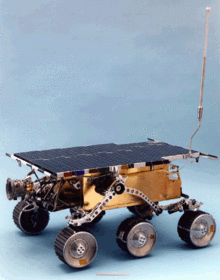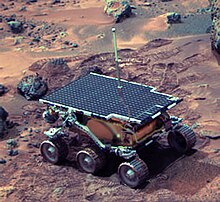Robotics/Exotic Robots/Hazardous Environment Robots
The definition of hazardous is involving or exposing one to risk.[1] Some examples of hazardous environments would be nuclear reactors, outside earth’s atmosphere, and even behind enemy lines in war. Robots help humans in many different ways; mostly being able to do task that could be harmful toward the average human being. So in society, robots perform important tasks that your average human being can not perform because of being to dangerous or harmful to their health.
Mars Pathfinder
[edit | edit source]





In space, robots have been used as rovers that travel to distant planets and take data from its surroundings, such as Mars Pathfinder. Using a rover is cheaper than sending humans into space. One of the missions was to “demonstrate a simple, low-cost system, at fixed price for placing a science payload on the surface of Mars at 1/15 the Viking price tag” (jpl.nasa). This is cheaper because going to Mars for humans would require the space shuttle to carry food and oxygen, be able to stand the extreme temperature differences, and especially, be safe enough to carry humans.[2]
Hubble Telescope
[edit | edit source]Another robot that is in space right now is the Hubble Telescope. The Hubble telescopes purpose is to provide “unprecedented deep and clear views of the Universe, ranging from our own solar system to extremely remote fledgling galaxies forming not long after the Big Bang 13.7 billion years ago” (hubble). This robot takes clear photos of the solar system. This is a great example of hazardous environment because the Hubble has been taking pictures since 1990 and aside of a few repairs, it has lasted a lot longer than was originally expected to last. [1]
Pioneer
[edit | edit source]Another application is in nuclear environments such as the aftermath of Chernobyl which a disaster that was cause by a nuclear reactor that released a large amount of radioactivity into the environment followed power explosion which destroyed the reactor. The Pioneer is a robot that was built to withstand the radioactive environment in order to deploy sensors, sampling payloads, map the environment in 3D, and cut and retrieve samples of structural materials. A robot has to be used because of rugged terrain, high radiation, and complete darkness (frc.ri.cmu). [2]
Pipeline Inspection
[edit | edit source]A variety of robots and robot-like devices are used to inspect pipelines. Some of them visually inspect more-or-less empty pipelines or pipelines full of clear water. Others use "fingers" to mechanically feel the interior shape of the pipeline, sensing interior pitting; or magnetically measure the thickness of the pipeline, indirectly sensing exterior pitting; or use other kinds of sensors while inspecting pipelines full of oil/sewage/etc. Most pipelines have at least one characteristic making robots more practical than direct human inspection: too narrow for an adult human to squeeze through, and too long to inspect the entire length from the ends; or filled with some unpleasant substance, or filled with some opaque substance, or some combination.
A common form of locomotion in a pipeline is to passively let the pressure of the product in the pipeline sweep the robot downstream.
Active locomotion is necessary when the pipe is empty or the robot needs to travel upstream. A robot can move through pipes using peristaltic locomotion,[3] wheels,[4] or a variety of other locomotion techniques.
Talon Sword
[edit | edit source]Robots are also used in war. From unmanned aerial vehicles or UAV to ground gunned vehicles, they are used because they put the soldiers out of the way of the bullets. The Talon Sword is used as a military ground robot that ranges from reconnaissance to weapons delivery. “The suitcase-portable robot [Talon Sword] is controlled through a two-way RF or F/O line from a portable or wearable Operator Control Unit (OCU) that provides continuous data and video feedback for precise vehicle positioning” (globalsecurity). This makes it easier for the soldier to operate out of range. [3]
Predator
[edit | edit source]Another robot used in the military is the Predator. The Predator is a UAV that was developed originally in 1996 and main purpose is to be used in armed reconnaissance, airborne surveillance, and target acquisition (af.mil). [4]
Conclusion
[edit | edit source]A major reason for robots is the fact that they can go more places than a human can. They are efficient and in most case get the job done that a human can not. And even though a robot that is built to perform in these hazardous environments cost anywhere from a couple hundred thousand to a couple hundred million, no robot cost is worth more than a human’s life.
Resources
[edit | edit source]- ↑ "Merriam-Webster: hazardous". Retrieved on 2008-12-01.
- ↑ California Institute of Technology: Jet Propulsion Laboratory: Robotics Section.
- ↑ Alexander Boxerbaum, et. al. "Continuous Wave Peristaltic Locomotion"
- ↑ Kyle Sherer. "Scientists developing intelligent pipe-inspection robot"
- ↑
- ↑
- http://mpfwww.jpl.nasa.gov/MPF/mpf/mission_obj.html. Retrieved on 2008-12-01
- ↑ "Military TALON Small Mobile Robot". Retrieved on 2008-12-01
- ↑ Air Force Link. "MQ-1 PREDATOR UNMANNED AIRCRAFT SYSTEM". Retrieved on 2008-12-01.
- ↑ NASA. "Hubble Space Telescope". Retrieved on 2008-12-01.
- ↑ "Project Pioneer". Retrieved on 2008-12-01.